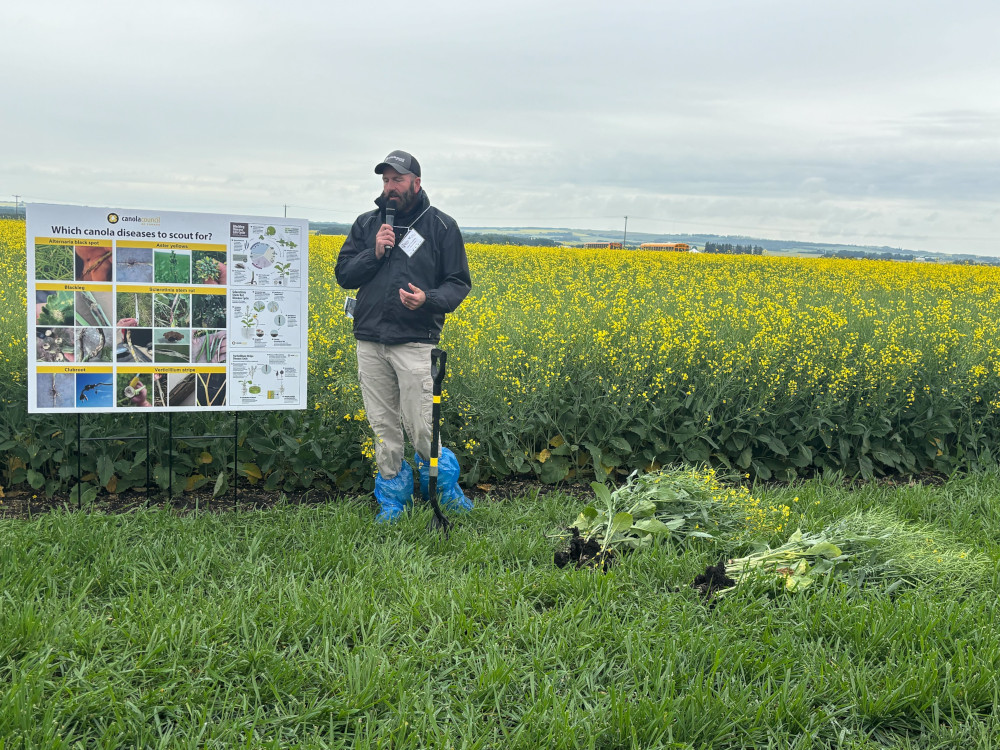As seed growers, you’re not just producing a crop — you’re producing potential. The canola you grow needs to perform across thousands of farms, under widely variable conditions. But even the best genetics can fall short without a clear understanding of how disease pressure impacts seed quality, yield, and marketability.
That’s why effective, timely scouting is so essential — not just for managing your own fields, but for protecting the integrity of the seed you supply. That was an important message from today’s Western Crop Innovations Field Day in Lacombe, Alta., where Canola Council of Canada agronomy specialist Jason Casselman spoke to farmers about canola disease.
Why Scouting Still Matters — Even in Seed Production
Yes, today’s canola genetics come equipped with strong disease resistance packages. But pathogens adapt, and environmental conditions shift. That means going beyond minimum inspections and making in-season disease monitoring a routine part of production.
Casselman walked through common canola diseases and discussed how to stay ahead of the curve.
Alternaria Black Spot
- Timing: Late-season, closer to swathing and harvest.
- What to watch for: Black spots on pods.
- Seed grower concern: While not a major yield robber, it can impact seed appearance and quality.
- Action: No effective in-season control. Focus on clean harvest timing and handling to prevent seed contamination.
Aster Yellows
- Timing: Mid- to late-season.
- What to watch for: Plants forming bladder-like growths instead of pods.
- Seed grower concern: Visual symptoms can alarm inspectors or buyers; not typically a yield threat.
- Action: Stay alert, especially if leafhopper pressure is high. Tracking initiatives (like the Leafhopper Project at U of A) are underway to improve forecasting.
Blackleg
- Timing: Infects early; symptoms show up later.
- What to watch for: Lesions on lower stems; dark internal streaks when stems are cross-sectioned.
- Seed grower concern: Chronic yield drag and increasing resistance breakdown.
- Action:
- Rotate genetics to avoid repeated use of the same R gene.
- Assess severity post-harvest using stem ratings.
- In high-pressure zones, consider early fungicide use.
- Maintain longer rotations where possible — repeated canola on canola fields raise seed infection risk.
Sclerotinia Stem Rot
- Timing: 20–30% bloom under humid conditions.
- What to watch for: White mold at stem bases, premature senescence.
- Seed grower concern: High disease severity can lead to disqualified seed lots and compromised seed development.
- Action:
- Monitor with the “wet pants test” — if you’re walking through wet canopies in the afternoon, conditions are ripe.
- Apply fungicides proactively, before visible petal drop.
- High-value seed fields may justify a second spray in heavy-pressure years.
Clubroot
- Timing: Mid-season or post-harvest scouting.
- What to watch for: Galls on roots.
- Seed grower concern: Even a single plant with confirmed clubroot can trigger field restrictions and damage reputation.
- Action:
- Always use a shovel — yanking plants can leave galls in the ground.
- Don’t rely solely on clubroot resistance. Monitor patches and volunteers.
- Be aware: resistant varieties can still host and spread new pathotypes.
- Infected fields can be barred from canola production for multiple years.
Verticillium Stripe
- Timing: Post-harvest or late season.
- What to watch for: Peeling, striped stems — not internal streaks like blackleg.
- Seed grower concern: Still under study, but may affect standability and late-season integrity.
- Action: Peel stems, don’t just cross-section. Monitor and report — better data is key to understanding its full impact.
Tools for the Job
- Shears or knives for cross-sections and stem ratings.
- Disease severity rating charts to document field status.
- Shovels for proper clubroot scouting.
- Access to historical variety resistance profiles to rotate genetics effectively.
Bottom Line for Seed Growers
If you’re in the seed business, you know clean fields equal clean seed. Scouting for disease isn’t just agronomic best practice — it’s quality control. It’s also a signal to your customers that you’re managing risk and delivering on genetics that perform.
For more detailed scouting guides, lifecycle charts, and disease management tools, visit the Canola Council of Canada’s resource hub:
👉 www.canolacouncil.org
Remember: Your genetics are only as good as the agronomy behind them. Scout early, scout often, and protect your seed value from the ground up.
